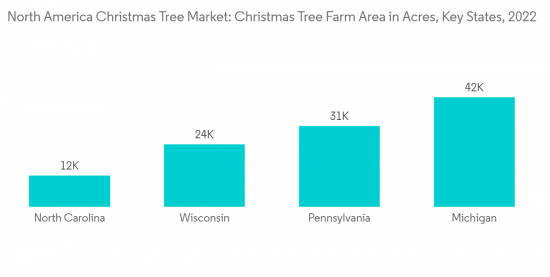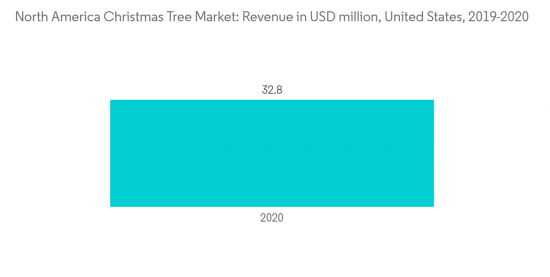PUBLISHER: Mordor Intelligence | PRODUCT CODE: 1333670

PUBLISHER: Mordor Intelligence | PRODUCT CODE: 1333670
North America Christmas Tree Market Size & Share Analysis - Growth Trends & Forecasts (2023 - 2028)
The North America Christmas Tree Market size is expected to grow from USD 1.33 billion in 2023 to USD 1.64 billion by 2028, at a CAGR of 4.28% during the forecast period (2023-2028).
Key Highlights
- Christmas is celebrated in all parts of the region. Due to their widespread popularity, natural Christmas tree production is a significant industry that makes sizable contributions to the rural economies of North America. According to the National Christmas Tree Association (NTA), over a hundred million households in the United States prefer to put a tree in their homes during the year-end holiday season. Between 25-30 million real, natural trees are sold each year.
- A growing awareness of environmental sustainability among the millennials compared to artificial variants increased the demand for natural Christmas trees, which has augmented the sales of fresh-cut real Christmas trees in the region in recent years.
- The price competitiveness between natural and artificial trees is expected to further drive the sales of real Christmas trees in the region. Real trees were sold at an average price of USD 81.0 per tree in the United States, against USD 107.0 for an artificial tree, aided by wider accessibility to freshly cut farm trees through online and offline retail platforms.
- The United States was the largest market for Christmas trees in 2022. According to the United States Department of Agriculture (USDA), there are 15,000 farms in the United States, ranging in size from 2 acres to 9 thousand acres. Approximately 434 largest farms control over 75% of the total supply in the United States market.
North America Christmas Tree Market Trends
Growing Consciousness Toward Environmental Sustainability
- Artificial trees are manufactured from several types of plastic and metal. Processing these components takes significant energy and causes significant pollution. sustainability and eco-friendliness are becoming increasingly important factors in consumer purchase decisions, particularly among younger generations.
- As such, the demand for environmentally-friendly products, including real Christmas trees, will continue to rise in the coming years. This factor further corroborates a shortage in the domestic supply in the region, as trees, once planted, need 7-10 years to grow. Although a sizeable portion of trees planted in eastern Canada is shipped to the United States every year, demand in the destined market still outpaces the exports.
- Real Christmas trees can also be recycled for a considerable amount of time without any underlying environmental threat and can be turned into mulch or biofuel. With a declining number of farms amid a shortage in operations by senior farmers, a new wave of young farmers is expected to fill the documented gap in the country, thus stabilizing the domestic supply in response to the growing demand in the coming years.
- Moreover, in 2018, Amazon responded to the reinvigorated trend of purchasing real Christmas trees by beginning to ship live trees across the region, including Douglas firs and Norfolk Island pines.

The United States is the Largest Market for Christmas Trees
- Christmas trees are grown and harvested in all 50 states of the United States. Five states, Oregon, North Carolina, Michigan, Pennsylvania, and Wisconsin, lead in terms of both tree production and sales. Around 30 million natural Christmas trees are sold annually in the United States. To fulfill the market demand, over 100 million trees are growing on more than 15,000 farms nationwide. The United States is also a top exporter of Christmas trees, with trees shipped to a number of countries, including Canada, Mexico, Brazil, Russia, Japan, China, and the Philippines.
- Throughout the United States, more than twenty species of Christmas trees are grown, including Cedars (Deodar and Easter Red), Firs (Balsam, Douglas, Fraser, Grand, Noble, Nordmann, White, Afghan, and Austrian), Pines (Red, Ponderosa, Scotch, Virginia, and White), Spruces (Black Hills, Blue, Norway, and White), and Leyland Cypress.
- In 2021, nationally, about one-quarter of natural Christmas trees were purchased from choose and cut farms, 28.5% from chain stores (like Costco or Home Depot), 16.2% from retail lots, 11.6% from nurseries, and the rest from other sources like churches or boy scouts. Furthermore, the growing inclination of millennial consumers toward traditional and environmentally sustainable trees is further anticipated to lead the market's growth during the forecast period.

North America Christmas Tree Industry Overview
The market for Christmas trees in North America is highly fragmented, as numerous players occupy the market with annual supplies of Christmas trees throughout the region. The players are vying for a significant market share by expanding franchises in strategic locations nationwide. Moreover, some players operate an extensive distribution network and retail partnerships to cater to the growing demand across all major countries in North America. Some of the most active companies selling real Christmas trees include JG Brands, Mr. Jingle's Christmas Trees, Big John's Trees, Tree Towne Christmas Trees, Santa's Trees, Grobe's Nursery and Garden Centre, Z & Z Christmas Trees, and Bastein Christmas Tree Farm.
Additional Benefits:
- The market estimate (ME) sheet in Excel format
- 3 months of analyst support
TABLE OF CONTENTS
1 INTRODUCTION
- 1.1 Study Assumptions and Market Definition
- 1.2 Scope of the Study
2 RESEARCH METHODOLOGY
3 EXECUTIVE SUMMARY
4 MARKET DYNAMICS
- 4.1 Market Overview
- 4.2 Market Drivers
- 4.3 Market Restraints
- 4.4 Porter's Five Forces Analysis
- 4.4.1 Bargaining Power of Buyers
- 4.4.2 Bargaining Power of Suppliers
- 4.4.3 Threat of Substitutes
- 4.4.4 Threat of New Entrants
- 4.4.5 Intensity of Competitive Rivalry
5 MARKET SEGMENTATION
- 5.1 Type
- 5.1.1 Douglas Fir
- 5.1.2 Noble Fir
- 5.1.3 Fraser Fir
- 5.1.4 Balsam Fir
- 5.1.5 Other Types
- 5.2 Geography
- 5.2.1 United States
- 5.2.2 Canada
- 5.2.3 Mexico
- 5.2.4 Rest of North America
6 COMPETITIVE LANDSCAPE
- 6.1 Most Adopted Strategies
- 6.2 Market Share Analysis
- 6.3 Company Profiles
- 6.3.1 J.G Brands
- 6.3.2 Mr. Jingle's Christmas Trees
- 6.3.3 Big John's Trees
- 6.3.4 Tree Towne Christmas Trees
- 6.3.5 Grobe's Nursery and Garden Centre
- 6.3.6 Santa's Trees
- 6.3.7 Bastein Christmas Tree Farm
- 6.3.8 Z & Z Christmas Trees
- 6.3.9 Saanichton Christmas Tree Farm
7 MARKET OPPORTUNITIES AND FUTURE TRENDS




